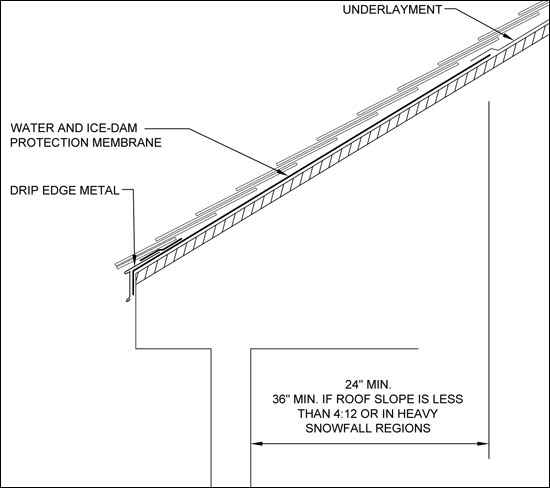If you do business in areas where ice damming is a problem, take the opportunity to educate your customers about ice damming. You will enjoy better business relationships with well-informed customers because ice damming facts you offer now will help influence their expectations when winter returns.
Each winter, NRCA Technical Services staff answers a wide variety of questions from property owners, contractors, architects, consultants, journalists and bloggers about ice dams. Knowing the answers to key questions may help position you as an expert in winter roof system care. Following are a series of relevant questions that will help assemble a foundation for understanding ice damming.
What causes ice dams?
Ice dams affect roof systems in cold, snowy climates. Ice dam causes can be traced to ineffectively insulated or air-sealed ceilings and heavy snow cover. Placing a heating system inside a ventilated attic of a home in a cold, snowy climate effectively guarantees ice dams.
But what defines a cold and snowy climate? Model code writers at one point used an approximation of an average daily temperature in January of 25 F or less, but that criterion was replaced in the 2006 model codes with language that essentially says to use local experience to decide.
Ice dams occur when snow-covered roof surfaces are warmed to above freezing in below-freezing weather. Snow-covered roof surfaces warm to above freezing when heat from below reaches the roof deck or there is enough of an insulating effect from the snow cover, sufficient solar radiation penetrates through the snow to the roof surface or a combination of these.
Building conditions commonly contributing to ice-dam formation include:
- Air leaks in the ceiling air retarder in locations such as access hatches, recessed lights, bathroom exhaust fans, chimneys, wall top plates, wire chases and plumbing stacks
- Insufficient amount of insulation in the attic or cathedral ceiling
- Thermal bridging at structural members
- Poorly insulated roof penetrations, including skylights and plumbing stacks
- Heating system and associated leaky ductwork in the attic
- Bathroom and clothes dryer exhaust vented into the attic instead of outside
- Ventilation openings blocked by insulation
These conditions also contribute to inefficient building energy use.
Heavy snow accumulation can have an insulating effect and raise the temperature above freezing at the roof surface independent of any heat loss below the roof. The magnitudeof this effect increases as the snow cover thickness increases.
A contractor installed ice-dam protection as part of my new roof, but there still are ice dams. What went wrong?
A water and ice-dam protection membrane is installed to prevent leaks when wind-driven rain or water trapped behind an ice dam travels upslope and laterally under shingle roof coverings. Water and ice-dam protection membranes do not prevent ice dams from forming and should not be solely relied on to prevent leaks.
An ice-dam protection membrane is a type of membrane underlayment designed to seal around nails and keep water from penetrating to the roof deck when it is adhered to a continuous roof deck and sealed at laps. Water and ice-dam protection membrane is NRCA's term for this membrane because its use is not limited to cold-weather regions. It is best to think of it as the last line of defense in addition to primary measures intended to address ice-dam root causes. If ice dams are present and there are no leaks, the contractor cannot be faulted—the water and ice-dam protection membrane is performing as designed.
A contractor installed a water and ice-dam protection membrane as part of my new roof in December, but the roof leaked after a heavy snowfall. What went wrong?
Cold-weather installation may provide the critical clue here. Water and ice-dam protection membrane manufacturers recommend conditioning the material to room temperature before installation in cold weather and installing the water and ice-dam protection membrane when temperatures are 40 F and rising or 50 F and rising, depending on the product.
In cold weather, self-adhering water and ice-dam protection membranes may need the application of heated air to assist sealing. At low temperatures, the adhesive in self-adhering water and ice-dam protection membrane sheets may not be sufficiently tacky to bond to a roof deck and at laps. Effective sealing still may happen at a later time when the roof has absorbed enough solar heat. If the membrane is not adhered and sealed at laps initially or over time, the material does not perform as a water barrier and leaks may occur at laps or penetrations when water backs up under the roof covering.
Alternatively, if there is evidence the water and ice-dam protection membrane was adhered and sealed effectively, leaks may be occurring in roof areas outside the membrane's coverage. In this case, the amount of accumulated ice may be extensive and pose a safety risk to traffic below and/or the roof structure. A professional roofing contractor should be contacted to address the immediate concern. The problem most likely is below the roof deck and should be addressed as soon as practical.
What are NRCA's recommendations for snow and ice removal from roofs?
For safety reasons, NRCA generally does not recommend homeowners attempt to remove ice dams or shovel snow off roofs because homeowners may cause more harm than good in some instances. The roof covering, flashings and gutters may be damaged during attempts to break up ice or by dragging a snow rake across the roof. Snow removal from a rooftop while standing on the ground typically results in snow being left on the roof's higher sections, which may lead to ice-dam formation above where a water and ice-dam protection membrane is installed. Where snow and ice buildup on a rooftop is an urgent problem, it is preferable to have a professional roofing contractor address it.
What is NRCA's position on heating cables?
NRCA advises against installing electric heat cables or heat-traced tape on roofs. Safely operating a live electrical conductor in a location exposed to weather and mechanical damage is the primary concern. Potential damage to roof systems resulting from fastening heating cables and localized heat also concerns NRCA. In addition, it is not prudent to rely on heating cables for ice-dam control because a roof will be without protection if the cable system stops working.
Finally, it doesn't make sense to use heating cables to address ice dams from a building energy-efficiency perspective. Ice dams primarily are caused by heat energy leaks through inadequately constructed building thermal and air barriers. Heating cable operation compounds the existing inefficiency and doesn't address the root cause of ice dams.
What are NRCA's recommendations for water and ice-dam protection membrane materials and installation?
Water and ice-dam protection membranes consist of single-layer applications of self-adhering polymer-modified bitumen sheets. NRCA recommends these types of self-adhering sheets comply with ASTM D1970, "Standard Specification for Self-Adhering Polymer Modified Bituminous Sheet Materials Used as Steep Roofing Underlayment for Ice Dam Protection," which should be designated on the packaging.
NRCA recommends water and ice-dam protection membrane installation under water-shedding roof coverings in areas where the average temperature for January is 30 F or less. A water and ice-dam protection membrane should be applied starting at a roof system's eaves and extend upslope to a point corresponding to a minimum of 24 inches—determined in the level plane—inside a building's exterior wall line (see the figure).
For slopes less than 4:12 (18 degrees) and in heavy snowfall regions, NRCA recommends water and ice-dam protection membranes be applied starting at the eaves and extending upslope to a point corresponding to a minimum of 36 inches—determined in the level plane—inside a building's exterior wall line. Where fascia boards are present at eaves, the sheet should be turned down the fascia behind the drip edge metal and an additional 6- to 10-inch-wide strip of the sheet should be used to strip in the drip edge metal flange. The membrane should extend up the adjoining walls to the top of wall flashing.

NRCA's recommended installation for a water and ice-dam protection membrane
In addition to downslope perimeters, NRCA recommends water and ice-dam protection installation at roof slope transitions, valleys and around penetrations.
Water and ice-dam protection sheet laps should follow manufacturer recommendations. Typically, manufacturers recommend side laps be a minimum of 3 1/2 inches and end laps be a minimum of 6 inches. The sheet should be adhered to the roof deck and sealed at laps.
Ice forming inside my gutters sometimes causes backups at the eaves. How do I prevent this?
Eliminating the gutters is the most effective preventive measure. If that is not an option, gutters should have a positive slope to drain and gutters and downspouts should be thoroughly cleared of debris before winter. Downspouts of open, partially open or corrugated cross-section should be used. If practical, they should not be located on a building's north side.
At eaves, a water and ice-dam protection membrane turned down the fascia behind gutters will provide a measure of protection against roof deck damage from water and ice backup.
Does NRCA recommend water and ice-dam protection membrane installation over an entire roof deck?
NRCA recognizes a single layer of self-adhering water and ice-dam protection membrane installed over an entire roof area is a viable underlayment configuration. Water and ice-dam protection membranes installed in this configuration act as vapor and air retarders and prevent drying of the roof deck to the outside. In heating climates (where vapor drive direction during winter months is from the inside to outside), a designer needs to carefully consider moisture transport through the roof assembly before a water and ice-dam protection membrane is installed over the entire roof deck.
Consider the following: In many cases, extensive ice damming on a roof indicates considerable amounts of heat and moisture from the conditioned space are reaching the underside of the roof deck through air leaks in the ceiling. Roof deck and structural members may be able to accommodate the resulting moisture buildup if it is released to the outside over time. When a water and ice-dam protection membrane is installed over the entire roof deck, moisture no longer can dry to the outside, and the resulting elevated moisture content may promote mold growth or compromise the roof structurally.
Does the building code in my area require ice-dam protection?
Only a local building code official or the text of the locally adopted code can provide a definitive answer. If those options are not available, checking the applicable model building code may provide an acceptable answer. Keep in mind model building codes such as the International Building Code (IBC) and International Residential Code (IRC) become legal requirements only after local governments adopt them. Local jurisdictions may choose to amend model code language, making it more stringent, before adopting it.
Most U.S. jurisdictions have adopted versions of IBC and IRC or have used IBC's and IRC's structures and content for the bulk of locally adopted codes. IBC applies to most construction except low-rise residential construction. IRC applies to construction excluded from IBC's scope and defined as detached one- and two-family dwellings and townhouses no more than three stories high with a separate exit and their accessory structures.
IBC and IRC provide separate requirements for different types of roof systems. The codes provide ice-dam protection requirements for asphalt shingle, metal shingle, mineral-surfaced roll roofing, slate and slate-type shingles, wood shake and wood shingle roof systems. The codes do not specifically address ice-dam protection for clay and concrete tile roof systems.
Where IBC 2006, 2009 or 2012 applies, ice-dam protection is required "in areas where there has been a history of ice forming along the eaves causing a backup of water" except for slate. IRC 2006, 2009 and 2012 provide the same language but add "… as designated in Table R301.2(1)." IRC 2006, 2009 and 2012 place the responsibility for determining the ice-dam protection requirement—as well as other criteria—on local code officials and provide blank space in Table R301.2(1), Climatic and Geographic Design Criteria, to set forth the criteria.
Where IBC 2000 or 2003 applies, ice-dam protection is required "in areas where the average daily temperature in January is 25°F (-4°C) or less or where there is a possibility of ice forming along the eaves causing a backup of water." This same language applies to slate roof systems in IBC 2006, 2009 and 2012.
IRC 2000 requires ice-dam protection "in areas where the average daily temperature in January is 25°F (-4°C) or less." This language remains in IRC 2003 but is modified with the addition of "… or when Table R301.2(1) criteria so designates."
The 2003 and later IBC and IRC provisions all contain exceptions from the ice-dam protection requirements for detached accessory structures that contain no conditioned floor area.
Where on the roof does my local building code require ice-dam protection?
As with the previous question, only the local code can provide the definitive answer.
All versions of IBC and IRC require ice-dam protection that extends from the lowest edges of all roof surfaces to a point at least 24 inches inside the exterior wall line of a building.
Where in the code can I find ice-dam protection requirements?
In IBC, ice-dam protection requirements are found in Section 1507—Requirements for Roof Coverings. In IRC, they are found in Section R905—Requirements for Roof Coverings.
IBC and IRC address ice-dam protection requirements in separate locations within text for each of the following: asphalt shingles, metal roof shingles, mineral-surfaced roll roofing, slate and slate-type shingles, wood shingles and wood shakes. The paragraphs applicable to asphalt shingles are 1507.2.8.2 and R905.2.7.1, respectively.
Also, 2012 IBC, Section 1510.3—Recovering versus replacement, and 2012 IRC, Section R907.3—Recovering versus replacement, provide exceptions from their tear-off requirements for an ice-dam protection membrane that is adhered to a roof deck. The existing membrane is permitted to remain in place and be covered with an additional layer of ice-dam protection membrane.
How can I prevent ice dams?
The most effective way to control ice dams is to design and construct a building so the roof surface temperature remains below freezing during weather that typically produces ice dams. A successful design's objective amounts to keeping stray interior heat from reaching the roof deck.
An important point to make here is the bulk of design and execution aimed at preventing ice dams has to do with construction below the roof deck in most design scenarios and, therefore, falls outside a roofing contractor's typical scope of work.
Different approaches have been used to successfully design ice dams out of buildings. The most common is a design that has three essential features: an effective air retarder at the ceiling; high thermal resistance value insulation on the attic floor; and ventilation with outside air by means of balanced openings at the eaves and ridge and unobstructed air space under the roof deck.
The requirements for ridding a ventilated attic of ice dams can be addressed more reliably and cost effectively in new construction compared with retrofits. On the other hand, retrofits can pay for themselves over time. In addition to controlling the cost of damage associated with ice dams, the outlined design addresses attic condensation problems and increases a building's energy efficiency. Because attic retrofits are a good idea, guides for contractors and homeowners have been developed. (See this article's Web exclusive for links to some of these resources.)
Is an unvented attic a good idea in an area with a history of ice-dam problems?
It can be. In unvented attics, air and thermal barriers are located at the roof plane. This is attractive because typically it is easier to construct an airtight roof than an airtight ceiling.
If enough insulation is used and the roof is airtight, an unvented attic assembly can work except for places where it snows a lot. Heavy snow cover—on the order of 1 foot of accumulation or more—can provide enough insulating value to melt the snow adjacent to a well-built unvented roof. In this scenario, a ventilation space under the roof covering—above the roof insulation—is needed to counter the insulating effect of a heavy snow blanket.
How much insulation is enough? And how does one define a lot of snow? Good answers can be found in Building Science Insights 046—Dam Ice Dam by Joseph Lstiburek.
Ventilation alone should not be relied on to solve ice-dam problems. In cold attics, ventilation works with the ceiling air barrier and attic insulation. It removes small quantities of heat and moisture that manage to get past the air and thermal barriers. The amount of ventilation air flow in a typical attic is insufficient to address significant air leaks through the ceiling.
Local building codes should be consulted before considering an unvented attic. A code may not permit unvented attic construction or may only allow it in specific scenarios. See "Vexing ventilation issues," page 32, for more information about ventilation code requirements.
Pass it along
Installing a water and ice-dam protection membrane along the eaves helps control problems resulting from ice damming but does not prevent it. Construction for effective control of ice dams has to address the root causes and those typically lie below the roof deck.
For typical residential construction, air sealing the ceiling plane, insulating the attic floor and providing balanced attic ventilation are the key components for an effective ice-damming solution. Because two of the three generally do not fall within the scope of roofing work, you may choose not to undertake all the work. In any case, inform clients about the complete scope of work needed to prevent ice dams.
Maciek Rupar is an NRCA director of technical services.



